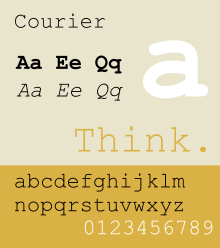Monospaced font

A monospaced font, also called a fixed-pitch, fixed-width or non-proportional font, is a font whose letters and characters each occupy the same amount of horizontal space.[1] This contrasts with variable-width fonts, where the letters differ in size from one another.
Note that this article generally assumes Western (Latin-based, Cyrillic, or Greek) writing systems. East Asian rules of typography, for example, require CJK fonts to be always monospaced at least as far as the main characters for writing words (i.e. not punctuation) are concerned. Other scripts vary in their use of monospaced fonts.
The first monospaced Western typefaces were designed for typewriters, which could only move the same distance forward with each letter typed.[citation needed] This also meant that monospaced fonts need not be typeset like variable width fonts and were, arguably, easier to deal with.
Examples of monospaced fonts include Courier, Courier New, and Lucida Console.
Use in computers
Monospaced fonts were widely used in early computers and computer terminals, which often had extremely limited graphical capabilities. Hardware implementation was simplified by using a text mode where the screen layout was addressed as a regular grid of tiles, each of which could be set to display a character by indexing into the hardware's character map. Some systems allowed colored text to be displayed by varying the foreground and background color for each tile. Other effects included reverse video and blinking text. Nevertheless, these early systems were typically limited to a single console font.
Even though computers can now display a wide variety of fonts, the majority of IDEs and software text editors employ a monospaced font as the default typeface. This increases the readability of source code, which is often heavily reliant on distinctions involving individual symbols. Monospaced fonts are also used in terminal emulation and for laying out tabulated data in plain text documents. In technical manuals and resources for programming languages, a monospaced font is often used to distinguish code from natural-language text.
The term modern is sometimes used as a synonym for monospace generic font family. The term modern can be used for a fixed-pitch generic font family name used in OpenDocument format (ISO/IEC 26300:2006) and Rich Text Format.[2][3]
Use in ASCII art
A monospaced font is often used in making ASCII art because of its ability to maintain the alignment of characters which are at the same position in different lines.
This is especially true in Line Drawing, where the characters are blocks and should be fixed-width.
| Normal font | Monospace font |
|---|---|
| ┌─┐ ┌┬┐ [example of line drawing characters] │ │ ├┼┤ [requires fixed-width, especially with spaces] |
┌─┐ ┌┬┐ [example of line drawing characters] │ │ ├┼┤ [requires fixed-width, especially with spaces] └─┘ └┴┘ [otherwise they are mis-aligned, as in the left.] |
Use in text-only grids
Monospaced fonts can produced an orthogonal grid for simple text-only board games. Or even in more elaborate text-only video games, such as Dwarf Fortress.
Use in biology
Monospaced fonts are preferred for displaying nucleic acid and protein sequences, as they ensure that the representation of every nucleotide or amino acid occupies the same amount of space. Alignment of the letters makes it easier to compare different sequences visually.
Use in guitar/bass music
Monospaced fonts are frequently used in tablature music for guitar and bass guitar.
Use in film and theatre
Both screenplays and stage play scripts frequently use monospaced fonts, since the length of the script determines the approximate length of the production. The industry standard is 12 point Courier.[citation needed]
See also
References
- ↑ Rosendorf, Theodore (2009). The Typographic Desk Reference. New Castle, Delaware: Oak Knoll Press. p. 12. ISBN 978-1-58456-231-3.
- ↑ OpenDocument v1.1 specification (PDF), retrieved 2010-05-01.
- ↑ Microsoft Corporation (June 1992), Microsoft Product Support Services Application Note (Text File) – GC0165: RICH-TEXT FORMAT (RTF) SPECIFICATION (TXT), retrieved 2010-03-13.